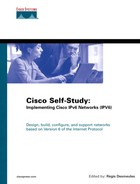Chapter 7
| 1: | What is the 6bone? | ||||||||||||||||||||||||||||||||||
| A1: | Answer: The 6bone is a test-bed network that was created to validate the new standards related to the IPv6 protocol, to test the IPv6 implementations and network services, to provide feedback to developers and protocol designers, and to validate operational procedures. | ||||||||||||||||||||||||||||||||||
| 2: | What name is assigned to backbone nodes physically and logically connected on the 6bone that exchange routes? | ||||||||||||||||||||||||||||||||||
| A2: | Answer: Backbone nodes on the 6bone that exchange IPv6 routes are called pseudo-TLAs. | ||||||||||||||||||||||||||||||||||
| 3: | What is not advertised by the pTLAs on the 6bone? | ||||||||||||||||||||||||||||||||||
| A3: | Answer: Because the pTLAs connect with each other in the default-free zone, no default IPv6 route is advertised on the 6bone. | ||||||||||||||||||||||||||||||||||
| 4: | What aggregatable global unicast IPv6 address space is assigned by the IANA for 6bone operation? | ||||||||||||||||||||||||||||||||||
| A4: | Answer: The IANA assigns the 3ffe::/16 prefix to the 6bone. | ||||||||||||||||||||||||||||||||||
| 5: | In the following table, specify whether the prefixes are allowed or prohibited on the 6bone according to the 6bone's routing policy.
| ||||||||||||||||||||||||||||||||||
| A5: | Answer:
| ||||||||||||||||||||||||||||||||||
| 6: | Which RIRs allocate IPv6 address space to providers? | ||||||||||||||||||||||||||||||||||
| A6: | Answer: APNIC, ARIN, RIPE NCC | ||||||||||||||||||||||||||||||||||
| 7: | Which aggregatable global unicast prefix did the IANA allocate for the production of the IPv6 Internet? | ||||||||||||||||||||||||||||||||||
| A7: | Answer: The IANA allocated the 2001::/16 prefix. | ||||||||||||||||||||||||||||||||||
| 8: | What IPv6 prefix length was allocated during the initial allocation policy by the RIRs in 1999? | ||||||||||||||||||||||||||||||||||
| A8: | Answer: The RIRs allocated /35 prefixes. | ||||||||||||||||||||||||||||||||||
| 9: | What are the main criteria to get IPv6 address space in the current allocation policy? | ||||||||||||||||||||||||||||||||||
| A9: | Answer:
Be a local Internet registry Do not be an end site Plan to provide IPv6 connectivity Plan to assign 200 /48 prefixes within two years | ||||||||||||||||||||||||||||||||||
| 10: | List the rules for the reassignment of address spaces to customers by the providers. | ||||||||||||||||||||||||||||||||||
| A10: | Answer:
Prefixes assigned to customers should be a /48 /64 prefixes may be assigned to subnets /128 prefixes may be assigned to a device | ||||||||||||||||||||||||||||||||||
| 11: | What are the basic steps for an ISP to become an IPv6 provider? | ||||||||||||||||||||||||||||||||||
| A11: | Answer:
Obtain address space for an RIR Peer with other TLAs Allocate prefixes to customers Aggregate route entries from the customers | ||||||||||||||||||||||||||||||||||
| 12: | List the two neutral scenarios presented in this chapter to establish IPv6 peering between the IPv6 ISPs in a NAP. | ||||||||||||||||||||||||||||||||||
| A12: | Answer:
Using link-local addresses for BGP4+ Using the aggregatable global unicast prefix registered by the NAP | ||||||||||||||||||||||||||||||||||
| 13: | Does the IPv6 Forum design standards and specifications for IPv6? | ||||||||||||||||||||||||||||||||||
| A13: | Answer: No. The IETF is responsible for designing standards and specifications for the IPv6 protocol. | ||||||||||||||||||||||||||||||||||
| 14: | List the main regional IPv6 initiatives/projects for Asia, Europe, and North America. Then list two international organizations that are considered important drivers for IPv6. | ||||||||||||||||||||||||||||||||||
| A14: | Answer:
Asia—Japan IPv6 Promotion Council Europe—European IPv6 Task Force, 6NET North America—North American IPv6 Task Force International organizations: IPv6 Forum and 3G | ||||||||||||||||||||||||||||||||||
| 15: | What is the main long-term goal of IPv6? | ||||||||||||||||||||||||||||||||||
| A15: | Answer: IPv6 provides a global standard allowing electronic communication networks and devices such as computers, PDAs, cell phones, televisions, satellites, and industrial machines to be interconnected within the same global digital network. |
..................Content has been hidden....................
You can't read the all page of ebook, please click here login for view all page.
